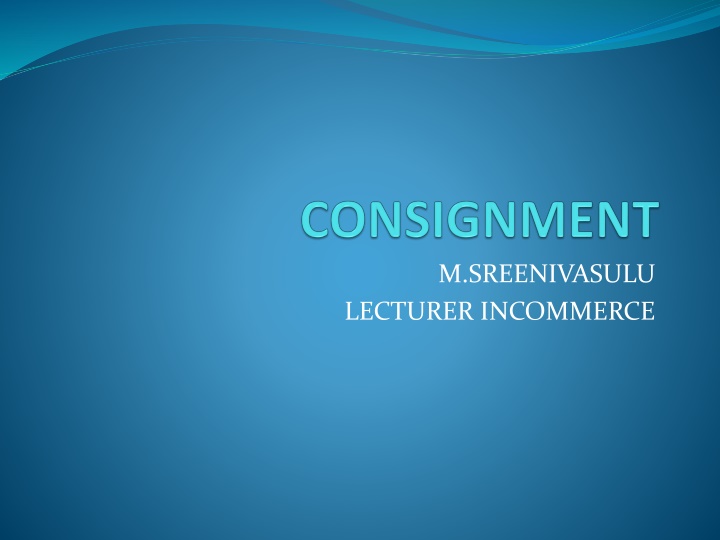
Consignment in Business: Meaning, Features, and Pros
Learn about consignment in business, a practice where a consignor hires a consignee to sell goods on their behalf. Explore the process, benefits, and key aspects of consignment arrangements to enhance sales and market expansion.
Download Presentation

Please find below an Image/Link to download the presentation.
The content on the website is provided AS IS for your information and personal use only. It may not be sold, licensed, or shared on other websites without obtaining consent from the author. If you encounter any issues during the download, it is possible that the publisher has removed the file from their server.
You are allowed to download the files provided on this website for personal or commercial use, subject to the condition that they are used lawfully. All files are the property of their respective owners.
The content on the website is provided AS IS for your information and personal use only. It may not be sold, licensed, or shared on other websites without obtaining consent from the author.
E N D
Presentation Transcript
M.SREENIVASULU LECTURER INCOMMERCE
Now a day in order to increase sales, manufacturers hire agents who can sell their goods as it might not be possible for them to look after the debtors and the sales. So also in the case of consignment, the principal hires agents for different places for a commission. Hereby, we discuss the consignment meaning, working, features, pros, and cons.
Consignment is a business arrangement between a consignor (owner) and a third party (consignee). This word has come from the French word consigner which means to hand over or to transmit . The consignee agrees to sell the goods handed over to him by the consignor for a fee. For the consignor, it is outward consignment and for the consignee, it is inward consignment. Also, there is another similar term called consignment shop. The consignment shop is a retail store which displays goods for the buyers for sale.
The possession of the goods transfers from one party to another. The consignor is responsible for all the risks, expenses and damages associated with the consigned goods. The relation of the persons in the consignment is that of consignor (principal) and the consignee (agent) and not of the buyer and seller. Only the possession of the goods is with the consignee and not the ownership. Profit or loss on the sale of the goods belongs to the consignor. The consignor sends Pro-forma Invoice. While the consignee sends Account Sales. Account Sales include the details regarding the goods, sales, expenses, commission, advances, and balances due.
To make large consignments and increase sales volume by attracting customers. To launch a new product and create and capture the market for the same. Earning higher revenue from a different geographical area for the same product. To grow and expand the business. Sustainment in the domestic and international market. To increase sales by utilizing the talent and expertise of the consignee.
The consignor sends the goods on consignment to the consignee. The consignee will separate the goods suitable for sales and the ones not suitable (usually torn, dirty goods which may be unsaleable in some jurisdiction). However, until there is an actual sale of the goods to a buyer, one cannot treat those goods as a sale. The terms are predecided for the revenue distribution of the sales and the time period for the goods held for sale. If the goods are not sold within that time period, the consignor reclaims those goods. However, there can be an extension in the time period if it is allowed as per the agreement. In the end, there is a final payment by the consignee to the consignor for the sales proceeds less his part of commission and expenses. Suppose there is a consignor Ohlin who consigns his 20 musical instruments to a consignee Richard . Richard pays some money in the form of advance to Ohlin. Here there is a transfer of the possession of the goods but not the ownership. However, Richard could only sell 18 instruments and agrees to buy the rest two at a 5% lesser price than the market price. Ohlin agrees for the same. If the instruments would have not yet been purchased by any, then the Ohlin would repossess them. At the last, Richard will do a final payment of the balances due by and to him. He will deduct his part of commission, expenses and obviously theadvance.
